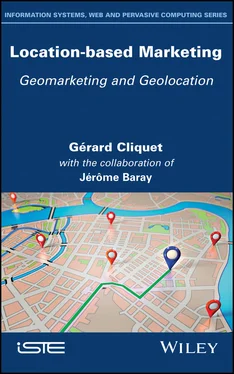Developing spatial marketing requires a clear understanding of two closely related phenomena referred to as location and localization. This book will deal with aspects related to both location and localization and therefore knowledge specific to management sciences, both those related to the geography of territories and those related to intercultural aspects. Social considerations will not be forgotten insofar as space and especially the ability to travel and move around it can be a source of inequality that has serious economic and social consequences (Fourquet 2019). Spatial mobility and the ability to change residence are one of the causes of unemployment.
Most individuals are able to acquire knowledge of space, including locations, distances and directions: we speak of “spatial intelligence” and even “brain GPS” (OʼKeefe et al . 1998) and “cells that constitute a geoposition system in the brain”, a kind of internal GPS. An article in the CNRS journal explains how this brain GPS works (Belaud 2019). This discovery answers the following questions:
How do we know where we are? How do we find our way from one place to another? And how do we store this information in such a way that we can immediately find the path the next time we take the same route?
There has even been an attempt to model this acquisition process without any real success (Montello 1998). These digital geographic tools and especially GPS can cause some people to lose all or part of their ability to explore new environments, and added to the development of artificial intelligence, may lead them to sink into the “planet of the apes syndrome” (Picq 2019).
Moreover, it is difficult today to separate a firm’s functions (namely marketing, information systems and human resources management, logistics, strategy, but also the underlying organizational forms) at local, regional, national and international levels. This is why many of the reflections in this book will focus on aspects other than marketing in the strict sense.
The communications revolution may have led us to believe that distance was “dead” (Cairncross 1997). This is not the case and it is time to rediscover space (Barnes et al . 2018). Digital mobility tools, smartphones and tablets are largely based on geolocation systems. Not taking geographical space into account in its decision-making processes could in the long-term lead to the company that refuses to comply with it becoming “obsolete”. It is true that in all markets, there are small firms that survive very well without using “new” technologies at all. But they often work in niches that are inaccessible to larger organizations. The latter explore the possibilities of Big Data in particular by relying on geolocated data, as about 80% of the data relevant to business is linked, in one way or another, to spatial considerations. These firms are developing data mining methodologies to improve their decision-making processes related to customer relationship management (CRM), hence the need to link marketing and information systems management (Goes 2014). In addition, space continues to play an essential role in the location of points of sale. Recent decisions by retail groups to close outlets are a telling example of this, if not perfect (see Chapter 4). We must be aware that today’s location strategies concern at least as much the opening of contact points as closures, in other words, network restructuring.
Finally, while this book aims to disseminate theories, concepts and methods, not to mention applications, it is also a call for more research focused on spatial marketing. Decision makers need a theoretical basis to interpret mapping results, better understand the consequences of introducing space into their decision-making process and once again develop finer strategies. This book is divided into five chapters according to the structure of a marketing manual (definitions and research techniques, consumer behavior, marketing mix with a stronger focus on location), with a contribution, in the last chapter, on mobile marketing even if information and communication technologies are present in all the chapters.
Chapter 1attempts to define spatial marketing as distinct from geomarketing and concepts and techniques to understand how mapping software adapted to geomarketing works.
Chapter 2summarizes knowledge of the consumer’s spatial behavior outside the points of sale as well as in the points of sale, without forgetting the cultural specificities linked to spatial diversity that product globalization has not eliminated. This chapter will mainly deal with shopping in its spatial dimensions.
Chapter 3focuses on the spatial marketing mix, that is, the combination of the famous 4 Ps (Product, Price, Place, Promotion) (McCarthy 1960) with the spatial diffusion of products, geomerchandising and geopricing, geopublicity, direct marketing, now interactive marketing and sales force management. The third P ( Place ) will be discussed in Chapter 4.
Chapter 4deals more specifically with georetailing since location methods were the first geomarketing management applications. Retailers are major users of geomarketing techniques, especially for setting up their points of sale, but we will see that other uses are possible.
Chapter 5, after recalling some considerations on e-commerce, covers both mobile shopping on the consumer side and mobile marketing on the business side, as well as m-commerce and mobile ICT applications, that is, smartphones and tablets, with their uses of geolocation in marketing.
1 1 https://dictionary.cambridge.org/fr/dictionnaire/anglais/retailing.
1
Spatial Marketing and Geomarketing
The terms “spatial marketing” and “geomarketing” call for the following questions:
– What is space?
– Why introduce space in marketing in an almost systematic, if not systemic way?
– Why expand the already vast field of geomarketing?
What is space? The recent French “yellow vest” crisis has shown how much making decisions without taking into account space or, as we now say, territories, can lead decision-makers to provoke reactions that are then very difficult to manage. Can we say that this “yellow vest” crisis invokes “geography is destiny”, as the American thriller writer James Ellroy likes to talk about? Making decisions today, either for private or public institutions without caring deeply about local issues can lead to a profound crisis. Everybody is not supposed to be mobile as expected.
Defining space and quickly understanding the consequences of these decisions on the “territories” for which we are responsible, whether at the level of a State or a company, are today prerequisites for good management of the organization for which we are responsible. However, the principle of subsidiarity (Martini and Spataro 2018) had been defined at the European level in the 1980s: “a central authority can only carry out tasks that cannot be carried out at a lower level” or “the responsibility for public action, when necessary, lies with the competent entity closest to those directly concerned by this action”, a recommendation that most companies cannot deny today. This principle has even been associated with the sustainable nature of economic activity in particular (Gussen 2015).
Why introduce space into marketing in an almost systematic, if not systemic, way? The reason is not only the need to localize all market characteristics (Rigby and Vishwanath 2006): customers, suppliers, points of sale, logistics and many other aspects revealed in this book. Even technological change requires us to take into account geographical space. The almost systematic use of GPS (Global Positioning System) and soon of the European Galileo system, is becoming increasingly present and is forcing all actors, suppliers and demanders as well as market facilitators to introduce spatial considerations into their reasoning, decisions and actions. The term systemic can also be used insofar as, if the company is considered as a system, it must now adapt as well as possible to its environment, whether for economic or environmental, or even social and cultural reasons.
Читать дальше












